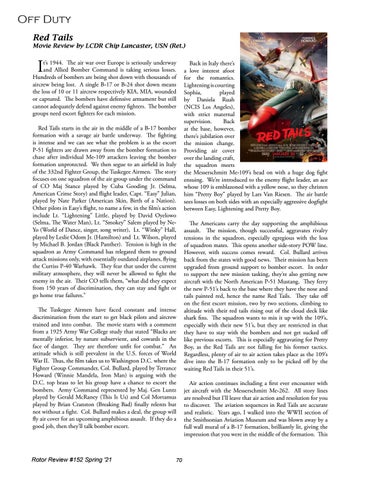Off Duty Red Tails
Movie Review by LCDR Chip Lancaster, USN (Ret.)
I
t’s 1944. The air war over Europe is seriously underway and Allied Bomber Command is taking serious losses. Hundreds of bombers are being shot down with thousands of aircrew being lost. A single B-17 or B-24 shot down means the loss of 10 or 11 aircrew respectively KIA, MIA, wounded or captured. The bombers have defensive armament but still cannot adequately defend against enemy fighters. The bomber groups need escort fighters for each mission. Red Tails starts in the air in the middle of a B-17 bomber formation with a savage air battle underway. The fighting is intense and we can see what the problem is as the escort P-51 fighters are drawn away from the bomber formation to chase after individual Me-109 attackers leaving the bomber formation unprotected. We then segue to an airfield in Italy of the 332nd Fighter Group, the Tuskegee Airmen. The story focuses on one squadron of the air group under the command of CO Maj Stance played by Cuba Gooding Jr. (Selma, American Crime Story) and flight leader, Capt. “Easy” Julian, played by Nate Parker (American Skin, Birth of a Nation). Other pilots in Easy’s flight, to name a few, in the film’s action include Lt. “Lightening” Little, played by David Oyelowo (Selma, The Water Man), Lt. “Smokey” Salem played by NeYo (World of Dance, singer, song writer), Lt. “Winky” Hall, played by Leslie Odom Jr. (Hamilton) and Lt. Wilson, played by Michael B. Jordan (Black Panther). Tension is high in the squadron as Army Command has relegated them to ground attack missions only, with essentially outdated airplanes, flying the Curtiss P-40 Warhawk. They fear that under the current military atmosphere, they will never be allowed to fight the enemy in the air. Their CO tells them, “what did they expect from 150 years of discrimination, they can stay and fight or go home true failures.” The Tuskegee Airmen have faced constant and intense discrimination from the start to get black pilots and aircrew trained and into combat. The movie starts with a comment from a 1925 Army War College study that stated “Blacks are mentally inferior, by nature subservient, and cowards in the face of danger. They are therefore unfit for combat.” An attitude which is still prevalent in the U.S. forces of World War II. Thus, the film takes us to Washington D.C. where the Fighter Group Commander, Col. Bullard, played by Terrance Howard (Winnie Mandela, Iron Man) is arguing with the D.C. top brass to let his group have a chance to escort the bombers. Army Command represented by Maj. Gen Luntz played by Gerald McRaney (This Is Us) and Col Mortamus played by Brian Cranston (Breaking Bad) finally relents but not without a fight. Col. Bullard makes a deal, the group will fly air cover for an upcoming amphibious assault. If they do a good job, then they’ll talk bomber escort.
Rotor Review #152 Spring '21
70
Back in Italy there’s a love interest afoot for the romantics. Lightening is courting Sophia, played by Daniela Ruah (NCIS Los Angeles), with strict maternal supervision. Back at the base, however, there’s jubilation over the mission change. Providing air cover over the landing craft, the squadron meets the Messerschmitt Me-109’s head on with a huge dog fight ensuing. We’re introduced to the enemy flight leader, an ace whose 109 is emblazoned with a yellow nose, so they christen him “Pretty Boy” played by Lars Van Riesen. The air battle sees losses on both sides with an especially aggressive dogfight between Easy, Lightening and Pretty Boy. The Americans carry the day supporting the amphibious assault. The mission, though successful, aggravates rivalry tensions in the squadron, especially egregious with the loss of squadron mates. This opens another side-story POW line. However, with success comes reward. Col. Bullard arrives back from the states with good news. Their mission has been upgraded from ground support to bomber escort. In order to support the new mission tasking, they’re also getting new aircraft with the North American P-51 Mustang. They ferry the new P-51’s back to the base where they have the nose and tails painted red, hence the name Red Tails. They take off on the first escort mission, two by two sections, climbing to altitude with their red tails rising out of the cloud deck like shark fins. The squadron wants to mix it up with the 109’s, especially with their new 51’s, but they are restricted in that they have to stay with the bombers and not get sucked off like previous escorts. This is especially aggravating for Pretty Boy, as the Red Tails are not falling for his former tactics. Regardless, plenty of air to air action takes place as the 109’s dive into the B-17 formation only to be picked off by the waiting Red Tails in their 51’s. Air action continues including a first ever encounter with jet aircraft with the Messerschmitt Me-262. All story lines are resolved but I’ll leave that air action and resolution for you to discover. The aviation sequences in Red Tails are accurate and realistic. Years ago, I walked into the WWII section of the Smithsonian Aviation Museum and was blown away by a full wall mural of a B-17 formation, brilliantly lit, giving the impression that you were in the middle of the formation. This







































